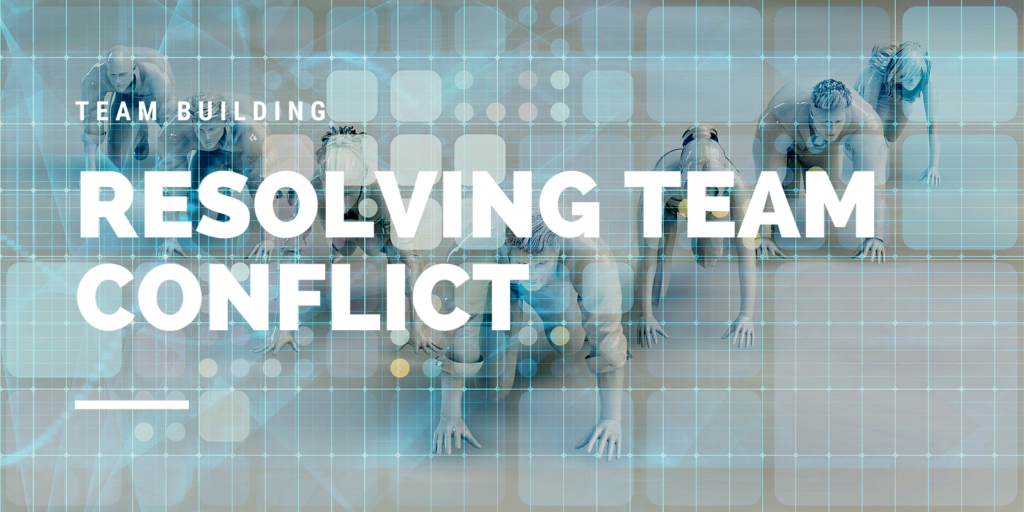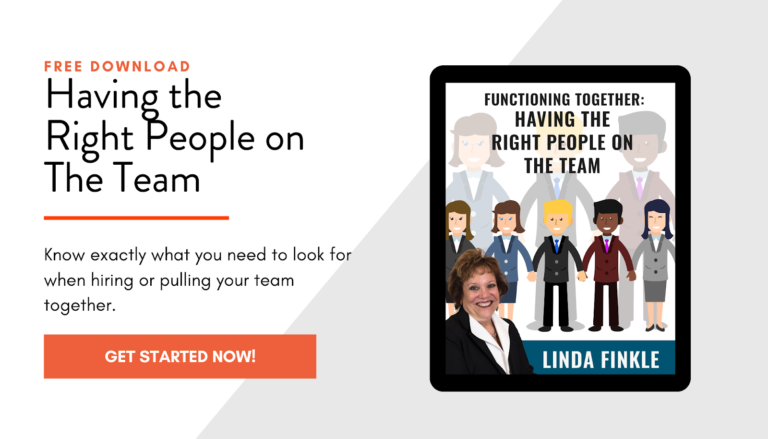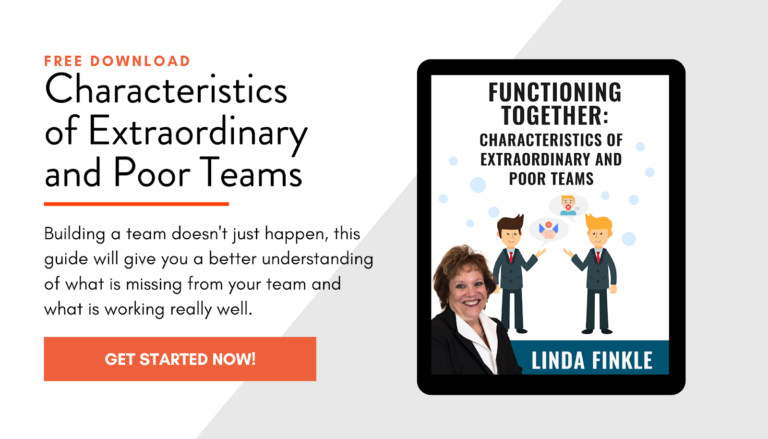High Performing Business Teams Don’t Just Happen
Great teams are what make high-performing companies work like a well-oiled machine. An ideal team is able to merge individual talents and skills into one cohesive unit with capabilities that surpass those of its most talented individual members. Whatever the reason a team comes together, teams are getting more of the work done more than ever.
In reality however, a lot of teams fail to even get close to the ideal. Members don’t work well together, or as cohesively as they could, people disengage, information isn’t shared, wires get crossed and, more often than not, money gets flushed down the drain.
So what makes a great team?
High-performing business teams aren’t products of happy accidents.
Great teams have high levels of participation, cooperation and collaboration because each member trusts the other, shares a strong sense of group identity and has confidence in the team as a whole.
How is that achieved?
This resource page has been created to provide you with help in building the team you want, and deserve. It provides real world examples of where having the right people on the team took a team from good to great, and how lack of delegating can wreak havoc, and so much more.
We have divided the resource page into six sections, each building on the section before. You’ll find tools, ideas and help throughout each section.
Read the articles and take advantage of the resources we provide. From learning how much or how well you delegate by taking the Delegation Quiz to learning how to interview effectively with The Art and Science of Interviewing Guide, to learning how to build consensus with Functioning Together: Consensus and Team Building, as well as others.
Start with the section on Having the Right People on the Team. Teams are made up of people and having the right people, in the right roles is the first step in creating the team of your dreams.
On this resource page we’ll cover the 6 areas that you need to focus on if you want to build a team that runs like clockwork:

How do you know if you have the right people on your team? Having the right people is the cornerstone of building a high performing team. However, more often than not we don’t have the luxury (or time) to build a team from scratch. Bringing a team together is time consuming. Having to hire to replace poor performing team members, or once thast self-select out comes at a cost.
As leaders in an organization, we often forget about the hidden costs of hiring, and those can be costly in terms of lost productivity. In this article about the High Cost of Bringing on New Employees I share the actual costs (plus the hidden, non-tangible costs) of bringing on a new employee.
Becoming a high-performing team takes a strong leader, willing to invest the time and having the patience to make this happen.
For high-performance to be manifested trust, talent and alignment need to be present.
Working with executives to help them build highly functioning teams, I have found that there is no ‘one size fits all’ answer to how one builds such a team; however, there are some guidelines that will help…here are my Top Five Tips for Building a Close-knit Team.
Great leaders know how to build their teams with winners. This means you need to know how to assess people so hiring should match your business needs, your culture and mesh well with the rest of the team members.
It may be intimidating to hire someone who is smarter than you but it does have it’s benefits:
- You improve your leadership skills because they will challenge you.
- You lower the amount of micromanagement it takes to get things done.
- It will help you stay ahead of the game because you need smart and creative people who will keep your business competitive with new ideas.
- It sets you up for effective succession planning when you have someone who is capable of stepping into a bigger role.
And remember, smartness isn’t limited to a person’s IQ—work experience, street smarts and expertise in other areas should be taken into consideration.
Where do you find those top recruits? It’s a good idea to look outside your industry.
What I have observed is that there is a tendency to play it safe and hire the same type of people over and over again. It’s very easy to look at a resume and search for specific words such as the same industry, technical competencies, years of experience and similar specifics, and use that to reassure yourself that this person will be a good fit.
This type of hiring can limit the growth of your company. Having a fresh set of eyes and new ideas can help move your business to the next level.
If you are fortunate, you will have multiple, highly qualified candidates from which to choose. But sometimes you do not.
Avoid taking the easy road and succumb to the temptation to hire less than the best person for your team. An employee who doesn’t meet the minimum requirements, who doesn’t fit the culture, who leaves interviewers feeling flat, will only slow down your company. Leave positions unfilled until the right person arrives.
If you don’t have the right people on the team you will spend huge amounts of time trying to engage employees, handle performance issues, manage team conflict, and more.
Having the right people will make your job as a leader easier.
And you can spend your time focusing on strategy, development and tasks that are of high value to the team and company. But first you have to build that team.
Find out how by downloading Functioning Together: Having the Right People on the Team.

A high-performing, well-integrated team needs a strong leader with a vision in order to foster collaboration.
As a leader you need to establish a clear vision of where the team is headed. Your vision must be communicated in simple language that everyone can easily understand and buy into it.
When you identify a clear vision and get buy-in from your team, this is what sets the foundation for your team to work together.
If you’re not quite there yet, perhaps you’re asking, “How can I win the commitment of people I work with?” In this article, I not only give you tips, but also a practical approach that you can easily apply to any given situation.
People working together come up with more options and solutions when faced with a problem. According to a study by Salesforce, 86% of those surveyed said that lack of collaboration and ineffective communication directly cause failure in the workplace.
Another study on collaboration cites that employees who collaborate with others, stuck at their tasks 64% longer than their solitary peers, whilst also reporting higher engagement levels, lower fatigue levels and higher success rates. Those are significant statistics that translate to dollars to your bottom line.
This is also the reason why team building should be considered a top priority for management. Just following standard practices of holding meetings and facilitating team building exercise isn’t enough to foster collaboration.
In this article I share 5 elements that can bring your team together and keep them that way. Key to this is having an influential leader who understands how to motivate his/her team and leads them authentically.
This is key to getting things done.
A great team doesn’t just happen by accident. Great teams have high levels of participation, cooperation and collaboration because each member trusts the other, shares a strong sense of group identity and has confidence in the team as a whole.
Simply put, great teams are made of individuals that support and respect each other, and are focused on achieving a goal.
Because I’ve found that most teams have a wide range of ages, I want to include some tips for managing teams comprised of varying age groups. In that article, I highlight the differences between Gen X and Gen Y, and give you tips on how to best manage them based on their unique needs.
Managers and/or business owners need to better understand their difference and have leadership skills good enough to bring these groups together.
The importance of creating the right culture in your organization so it fosters collaboration even when employees are sorely tempted to look out for themselves first, can’t be stressed enough.
Achieving this culture maybe easier said than done, however, the payoff will show up in your team as:
- Increased levels of engagement.
- Improved employee retention.
- Increased productivity, even when working solo or remotely.
- Lower levels of fatigue.
- A higher success rate of projects.
It takes hard work, patience, continued interaction and a strong desire to build a solid team.
If you want to build a team that is extraordinary you have to bump it up even more. What does it take to move your team from ordinary to extraordinary? Download our guide of this name and find out.

Effective delegation is critical to the success of any organization.
I’ve seen examples where leaders just delegate to get things off their plate and others who are reluctant to delegate because they don’t believe anyone can do it better than they can.
Whether you fall in the push it off your plate or do it all yourself camp, the key to becoming a successful delegator is to start by defining what you want, and communicating your expectations clearly. You cannot hold anyone accountable until you are certain they are clear about what you want, and have committed to do it. Accountability requires specificity on your part, and agreement on their part.
This success story of how a senior executive with a Fortune 500 company was able to move from being a do it all herself leader to becoming a successful delegator will show you how she made some simple shifts. As a result, her team was performing to a higher level than they had since she had taken over the leadership of them.
In my article 7 rules for effective delegation, I point out that the key to being successful when handing off tasks and projects to others is mostly dependent on you, maybe more so than the other person.
When delegating to others, you have to want them to be successful and give them the tools and information they need to complete the task/project.
Key to this is continuing to be engaged with the task/project and following up with whoever you delegate to.
What if you don’t have a team or someone you can delegate to?
You’re feeling overwhelmed, there is just too much stuff to do and it seems that every time you turn around your boss is asking you for something else. What can you do when you don’t truly have responsibility for someone as a manager so there isn’t someone to whom you can hand things off?
You can delegate even without a team and it starts with shifting your thinking about delegation. Shifting your thinking means stepping back from thinking/believing that you have to be all things to all people, all the time. One way to do this is to ask for help…it’s the same thing as delegating.
But in order to ask you have to get over believing you shouldn’t ask. Instead think of it as a gift, most people genuinely want to help, and enjoy being asked.
What are the common mistakes people make when delegating?
It’s all too easy to just push off tasks and projects to anyone who may seem like they have the bandwidth. Instead it is wiser to think things through so that you are 100% clear about what you want done and by whom.
Don’t make the mistake of assuming that others are committed and will get it done. Start by making sure you are clear and specific about the task you are delegating, and your expectations. Build in regular checkpoints along the way to make sure everything is moving along smoothly, and that there are no surprises.
Being an effective delegator is challenging for most leaders.
You’re concerned it won’t be handled to your satisfaction, or that you’ll have to take time to redo it, and along the way you have lost all control. Not a great feeling and thus it’s understandable to want to hold onto projects/tasks rather than delegate. You cannot grow or take on more interesting or strategic initiatives though until you learn to delegate.
Take our Delegation Quiz and learn your delegation style, and how to determine if it’s supporting you or getting in your way.

We often make the mistake of thinking a one size fits all approach will work when motivating people on a team.
However it is critical for you to understand the passions, drivers, and the “what gets me out of bed each morning” for each person on your team.
Why? Because motivated employees are proven to drive business impact—you will experience lower turnover and absenteeism, and ultimately stronger business outcomes, as measured by shareholder return and revenue performance.
According to Gallup’s State of the American Workplace report, the majority of the U.S. workforce (67%) is not engaged and motivated.
Companies where employees are engaged, according to Gallup have a 41% reduction in absenteeism and a 17% increase in productivity and they are more likely to experience lower attrition rates. It’s what every company wants.
At this point, you may be asking yourself: How can I effectively motivate my employees, given their varied internal motivators, interests, desires, and needs?
Don’t you wish that your employees came to work every day clicking their heels and couldn’t wait to get down to work? We all know this isn’t realistic 100% of the time and yet there are things you can do to move closer to this goal.
In this article on attitude adjustment and where employee motivation fits in I share tips on how to get to the root cause of a motivational issue by asking the right questions.
Do you have people on your team performing boring and mind numbing jobs? First of all resist the temptation to just add more tasks to their to-do list. The bottom line is no one would be happy to find out that you’ve just added more mundane work to his already boring day.
Instead you want to add spice to those boring and repetitive tasks:
Change up the routine by giving them the freedom to choose the order of work.
Provide employees, even at the lowest ranks in your organization, with a chance to move up by offering training, certifications and opportunities for advancement.
Crossing training is one of the best ways to motivate employees because it’s a win-win for both parties.
And don’t forget to be honest and try to connect with them on a human level. Instead of sugar coating the situation, tell them how things are and then ask for suggestions.
How to engage and motivate employees has been an ongoing focus for companies, as it is a critical component of employee attraction and retention.
A great example of why it is so important to hand off responsibility rather than doing it yourself is in this article: Achieving Results Without Doing It Himself. It’s the story of a key executive who was stuck in giving too much advice on how to do whatever he was delegating, or doing things himself and because of this he left his team feeling unmotivated to do more than just their job.
We focused on how he could achieve results, without him being the one to handle. He learned that his team was smart and capable, and that his role had to change.
As he moved away from giving advice, acting quickly to handle a situation and rushing in to fix problems, others stepped in to fill those roles.
In today’s workforce, an engaging work environment is a fundamental expectation, a baseline requirement for most job seekers and employees. An engaging environment includes employees being able to take on new roles and responsibilities, and use their own creativity and insights to solve problems or handle situations.
For you as a leader, this means that creating a company with a culture of engagement and motivation is no longer optional, if you want to build a highly successful business.
Solid teams are built, they don’t simply come together by themselves.
Look around and you’ll notice some teams work well together, produce consistent high quality results, and are having fun. Others are complaining constantly, bickering with each other, work quality is subpar and the manager spends more time hand holding than leading. What’s the difference?
Download Functioning Together: Characteristics of Extraordinary and Poor Teams. And then assess your own team against the characteristics listed.

Productive employees are the lifeblood of any successful business, but how do you assess their performance levels? Do they understand your goals and expectations? Are they meeting them? Is their performance consistent or inconsistent? How are they performing against their personal objectives?
As a leader, you must continually monitor and evaluate people on your team.
Key performance indicators (KPIs), sometimes referred to as key success indicators (KSIs), are measurements that a company uses to evaluate their success at reaching targets. They help leaders and employees gauge the effectiveness of various functions, processes, and other areas important to achieving organizational goals.
KPIs provide you with a more complete picture of your business or department. They help you make better business decisions.
Performance reviews are an essential part of this evaluation process. I have yet to meet a manager who enjoys doing employee performance reviews, unless they include discussing outstanding performance, a promotion or something else positive.
Unfortunately, these performance reviews are often handled poorly, causing employees to feel demotivated, dismissed and uncared for, instead of helping them see where they can improve at their role. In so many cases, performance reviews are often seen as a routine task or a formality. And since that is the case they are handled with a perfunctory attitude, which comes across to the employee.
When done well, a performance review can serve as a way to encourage an employee to perform better.
Performance Reviews can Boost Employee Development if:
- You review employee performance, both good and bad, compared to the company’s KPIs.
- Give feedback that shows success, and point out areas for development. Show the employee’s contribution to the company’s vision and goals.
- You practice following through. A performance review serves to remind the employee and his manager of his past performance, but without follow-through, those goals could easily be forgotten.
Is it possible to make these interactions less awkward and/or painful for both you and the employee and a conversation you look forward to having rather than avoid? YES!
- Don’t think of it as an opportunity for a confrontation.
- Thinking it only as an opportunity to point out areas for improvement or development.
- Not giving specific examples when discussing their performance.
- Putting off the review instead of having them on a regular basis.
- Not being 100% honest.
How do you handle the situation if the performance review fails to get the results you were seeking and you have to resort to terminating an employee?
Nobody likes to terminate an employee, however, sometimes it is inevitable and this is when knowing how to fire an employee is crucial to a business’ success, and to some point, its survival.
Employees are the cornerstone of every company. When they perform well, the company soars, but when they start to lag behind and neglect their duties, the company starts incurring all sorts of losses. It is thus essential for company leaders to know when to weed out employees before the affect others
To avoid legal complications and to ensure that the process goes smoothly, I suggest you go through this list of five no-no’s when it comes to terminating employees.
- Not having a signed offer letter or employment agreement when you hired them.
- Terminating without having the proper documentation.
- Terminating an employee without a legal work related reason.
- Not preparing for the termination process .
- Talking too much during the termination process.
Instead, and to avoid possible complications, it’s best you learn how to terminate an employee the right way.
- The termination shouldn’t come as a surprise.
- Follow the proper procedures and have full documentation.
- Handle the termination conversation in a private setting.
- Have a third party in the meeting.
- Be compassionate and don’t be misleading.
If you have an employee over the age of 40 that needs to be let go, there are special rules that you should consider when terminating them.
Did you know that employees 40 years old and above are covered under the Older Workers Benefit Protection Act, which is also known as the OWBPA?
This is part of the Age Discrimination in Employment Act, or ADEA, which prohibits employers from discriminating against older employees during hiring, training, and of course up to the termination process.
Terminating an employee is never fun but understanding and having the proper procedures in place is crucial for your business’ income and continuity.
You don’t want to constantly deal with an employee’s mediocre performance, do you? Aside from that, terminating an employee properly will prevent unnecessary stress with possible lawsuits and employee uproars.
There is nothing wrong with letting an employee go, so long as you do it right.
As the leader it is up to you to motivate your team, measure their performance and weed out any non-performers who make it hard for your team to function successfully.
One way to hire more effectively, and eliminate performance problems is to use assessments during the interview process.
Download our Assessing the Value of Assessments guide and learn the 8 reasons using assessments can boost your hiring and success.

Any time you put more a team of people together there is bound to be workplace conflict, there is no getting around this fact.
Here’s some statistics that show the cost of conflict in the workplace:
Conflict costs US employers around $359 billion in paid hours each year according to CPP Global’s Human Capital Report.
Their study reported that US employers spend on average almost 3 hours per week dealing with conflict. The costly side effects of unmanaged conflict include absenteeism, high turnover rates, poor engagement, and litigation.
In that same report they found that clashing egos was the #1 leading cause of conflict in the office at 49%, followed by stress at 39%, and in third places was heavy workloads being the third biggest cause of conflict.
Another study on workplace conflict by Randstad in 2018, found that a toxic office environment and poor reputation can potentially repel applicants or lead current employees to quit.
Randstad study showed that 58% of employees leave their jobs because of office politics.
And even more importantly this has an effect on future hiring, around 86% of workers won’t even consider applying for a company that has negative reviews.
The question remains, what is management’s role in creating employee conflict, and is there anything they can do to reduce conflict?
Are companies destined to spend a significant amount of their time resolving conflicts? Or is there a way to lower the volume and the frequency of this problem?
In the article Employee Conflict, Is It Management’s Fault, I cover the 9 ways employee conflict is management’s fault. I point out that in order to prevent or minimize conflict, you, as the leader, need to step up and take responsibility for what your role is in creating, exacerbating, or prolonging the workplace conflict.
Then, and only then, significant change can begin.
So, how do you the leader keep your wits about you when things get testy? Learning to step back and regain your composure is more than a skill in self management, it’s critical for your career success. I also share 5 easy ways to quickly regain your equilibrium so you can get your focus back on your work.
When it happens the tendency is to believe it’s the other guy’s fault; your passive-aggressive colleague, the boss who is incompetent, the peer who is always complaining about something, or maybe even the culture that exists in your company where no one takes accountability and responsibility is misdirected.
You’re probably thinking yep so there is nothing I can do, but you would be incorrect. You can’t change other people, but you can change yourself.
When you change yourself, that’s the best first step you can take to end the cycle of stress, frustration and anger in your workplace.
A great example of where this worked is in a company I worked with that had huge communication challenges and conflict between team members and leadership. In our work together, we were able to resolve them and become calmer, less frustrated and complaints dropped to almost zero.
This was achieved by helping key people focus on something they could control, themselves.
They came to understand that battling wills with the person who was causing the issues within their company wasn’t going to change anything. And, when they were able put their own ego aside and a need to win and resist showing the perpetrator how wrong they were, progress was made.
If you feel like you need more techniques to resolve workplace conflict, I’ve got 14 tried and true ways in this article.
Remember, a calm and seemingly together person can be pushed to the edge at any given time. So many things can get in the way of our being able to manage conflict without letting our emotions get out of control and keep us from managing things the way we would like to.
Take the time to learn the techniques to resolve conflict when it occurs so it’s just smoke instead of fire, which is a lot easier to quelch.
When conversations turn ugly, fists are up and pistols drawn it’s time to lower the tension and move towards resolution.
Yet in the midst of high emotions it’s difficult to know what to do.
Download our Healthy and Unhealthy Ways to Manage Conflict checklist. You’ll discover the tools you need, and what you might be doing that perpetuates the situation.






